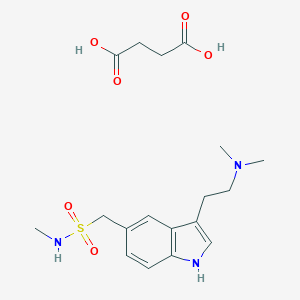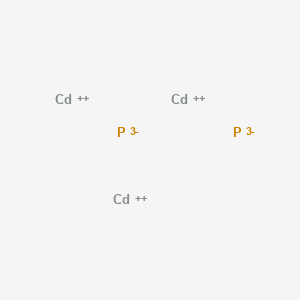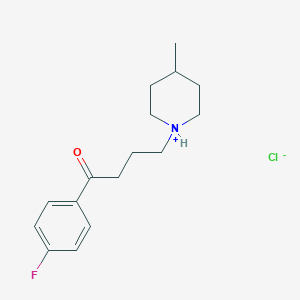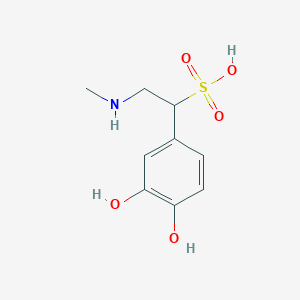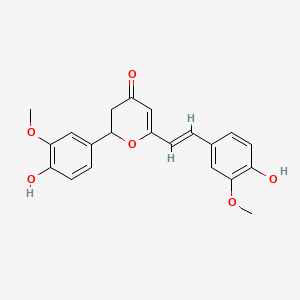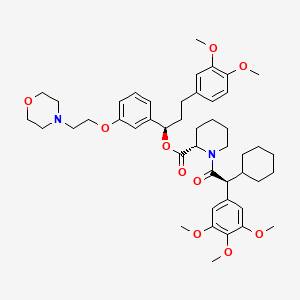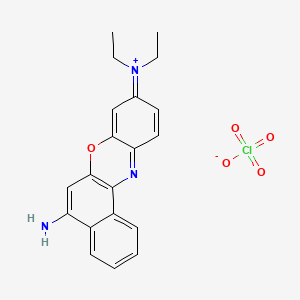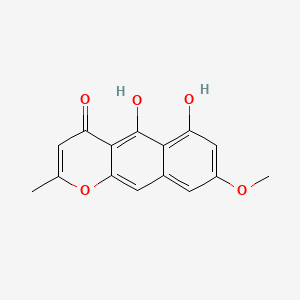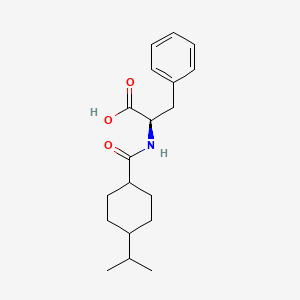
Nateglinide
描述
Nateglinide is an oral antihyperglycemic agent used for the treatment of non-insulin-dependent diabetes mellitus (type 2 diabetes). It belongs to the meglitinide class of short-acting insulin secretagogues, which act by binding to beta cells of the pancreas to stimulate insulin release . This compound was developed by Ajinomoto, a Japanese company, and is marketed under the trade name Starlix by the Swiss pharmaceutical company Novartis .
准备方法
Synthetic Routes and Reaction Conditions: Nateglinide is synthesized from R-phenylalanine and trans-4-isopropyl cyclohexane carboxylic acid. The synthesis involves the formation of an amide bond between the amino group of R-phenylalanine and the carboxyl group of trans-4-isopropyl cyclohexane carboxylic acid . The reaction typically requires the use of coupling reagents such as dicyclohexylcarbodiimide (DCC) and 1-hydroxybenzotriazole (HOBt) to facilitate the formation of the amide bond.
Industrial Production Methods: In industrial settings, this compound can be produced using a similar synthetic route but on a larger scale. The process involves the use of large reactors and precise control of reaction conditions to ensure high yield and purity of the final product. The use of automated systems for monitoring and controlling the reaction parameters is common in industrial production .
化学反应分析
Types of Reactions: Nateglinide undergoes various chemical reactions, including:
Oxidation: this compound can be oxidized to form its corresponding sulfoxide and sulfone derivatives.
Reduction: Reduction of this compound can lead to the formation of its reduced amine derivative.
Substitution: this compound can undergo nucleophilic substitution reactions, particularly at the amide nitrogen.
Common Reagents and Conditions:
Oxidation: Common oxidizing agents such as hydrogen peroxide or m-chloroperbenzoic acid (m-CPBA) can be used.
Reduction: Reducing agents like lithium aluminum hydride (LiAlH4) or sodium borohydride (NaBH4) are typically employed.
Substitution: Nucleophiles such as amines or thiols can be used under basic conditions to facilitate substitution reactions.
Major Products:
Oxidation Products: Sulfoxide and sulfone derivatives.
Reduction Products: Reduced amine derivative.
Substitution Products: Various substituted amides depending on the nucleophile used.
科学研究应用
Pharmacological Mechanism
Nateglinide is an amino acid derivative of D-phenylalanine that exerts its effects by binding to ATP-sensitive potassium channels in pancreatic beta cells. This interaction leads to an increase in intracellular calcium concentration, promoting insulin release. The pharmacokinetics of this compound demonstrate rapid absorption with a bioavailability of approximately 72% and a short elimination half-life of about 1.4 hours, necessitating administration shortly before meals to optimize its effectiveness .
Type 2 Diabetes Management
This compound is primarily indicated for the treatment of type 2 diabetes mellitus, either as monotherapy or in combination with other agents such as metformin. Clinical studies have shown that this compound effectively reduces postprandial glucose levels and improves overall glycemic control. For instance, a combination therapy of this compound and metformin has been demonstrated to provide superior glycemic control compared to either agent alone . The maximum effective dosage is typically 120 mg taken before meals .
Case Studies and Clinical Trials
Numerous clinical trials have assessed the safety and efficacy of this compound:
- Efficacy in Combination Therapy : A study involving patients with inadequately controlled type 2 diabetes on metformin showed that adding this compound significantly improved glycemic control, with reductions in both fasting plasma glucose and postprandial glucose levels .
- Safety Profile : The most common adverse effects reported include nausea, diarrhea, dizziness, and lightheadedness. Importantly, the drug has a favorable safety profile when used appropriately .
Nanotechnology in Drug Delivery
Recent studies have explored innovative delivery methods for this compound using nanotechnology. For example, research indicates that this compound can be used as a coating for alginate microspheres to enhance oral delivery systems for insulin. This approach aims to overcome challenges related to low bioavailability and rapid elimination of therapeutic agents in the gastrointestinal tract .
Comparative Efficacy Studies
Ongoing research continues to compare this compound with other antidiabetic agents like repaglinide and traditional sulfonylureas. These studies aim to elucidate the relative advantages of this compound regarding onset of action, duration of effect, and overall patient outcomes .
Summary Table: Key Characteristics of this compound
| Characteristic | Details |
|---|---|
| Drug Class | Meglitinides |
| Mechanism of Action | Stimulates insulin secretion via ATP-sensitive K+ channels |
| Bioavailability | ~72% |
| Half-Life | ~1.4 hours |
| Common Dosage | 60-120 mg before meals |
| Adverse Effects | Nausea, diarrhea, dizziness |
| Combination Therapy | Effective with metformin for enhanced glycemic control |
作用机制
Nateglinide exerts its effects by stimulating insulin secretion from the pancreas. It achieves this by interacting with the ATP-sensitive potassium channels on pancreatic beta cells. This interaction leads to the closure of these channels, resulting in the depolarization of the beta cell membrane. The depolarization opens voltage-gated calcium channels, allowing calcium ions to enter the cells. The influx of calcium ions triggers the exocytosis of insulin-containing vesicles, leading to the release of insulin into the bloodstream .
相似化合物的比较
Nateglinide is often compared with other meglitinides and antidiabetic agents, such as:
Repaglinide: Another meglitinide with a similar mechanism of action but a longer duration of action.
Metformin: A biguanide that improves insulin sensitivity and reduces hepatic glucose production.
This compound’s uniqueness lies in its rapid onset and short duration of action, making it particularly effective in controlling postprandial blood glucose levels without significantly increasing the risk of hypoglycemia .
生物活性
Nateglinide is an oral antidiabetic medication belonging to the meglitinide class, primarily used for managing type 2 diabetes mellitus (T2DM). It functions as a rapid-acting insulin secretagogue, stimulating insulin release from pancreatic beta cells in a glucose-dependent manner. This article explores the biological activity of this compound, its mechanisms of action, clinical efficacy, safety profile, and comparative studies with other antidiabetic agents.
This compound's biological activity is closely linked to its mechanism of action:
- Insulin Secretion : this compound binds to ATP-sensitive potassium (KATP) channels on pancreatic beta cells, inhibiting their activity. This inhibition leads to membrane depolarization and subsequent opening of voltage-gated calcium channels, resulting in increased calcium influx and stimulation of insulin secretion .
- Glucose Dependency : Unlike sulfonylureas, this compound's insulinotropic effect is glucose-dependent; it enhances insulin release primarily at intermediate glucose levels (3 to 10 mmol/L) and does not stimulate insulin secretion at low glucose concentrations . This property minimizes the risk of hypoglycemia, a common side effect associated with other insulin secretagogues.
Pharmacokinetics
This compound exhibits rapid absorption and elimination characteristics:
- Absorption : The drug is absorbed quickly from the gastrointestinal tract, with peak plasma concentrations reached within 1 hour post-administration. The bioavailability is approximately 72% .
- Half-Life : this compound has a short half-life of about 1.8 hours, which prevents drug accumulation in the body and necessitates administration before meals for optimal efficacy .
Clinical Efficacy
Numerous studies have evaluated the efficacy of this compound in controlling blood glucose levels in patients with T2DM:
- Long-Term Studies : A study involving 1,014 patients over 15 months reported significant reductions in fasting blood glucose (decrease of 9.3 mg/dL) and postprandial blood glucose (decrease of 53.2 mg/dL), alongside a reduction in HbA1c levels by 0.68% . The overall efficacy was rated at 78.76% by treating physicians.
| Parameter | Baseline | Post-Treatment | Change |
|---|---|---|---|
| Fasting Blood Glucose (mg/dL) | 155.1 ± 40.0 | 145.4 ± 35.1 | -9.3 |
| Postprandial Blood Glucose (mg/dL) | 223.8 ± 61.1 | 170.6 ± 40.7 | -53.2 |
| HbA1c (%) | 7.51 ± 1.36 | 6.83 ± 1.09 | -0.68 |
- Comparative Studies : A randomized trial comparing this compound to repaglinide showed similar efficacy in lowering HbA1c levels and fasting plasma glucose, indicating that both medications are effective but may differ in patient-specific responses .
Safety Profile
This compound is generally well-tolerated, with a low incidence of adverse effects:
- Adverse Reactions : In long-term studies, adverse reactions occurred in approximately 10% of patients, with hypoglycemic symptoms being the most common (1.91%) . Importantly, serious hypoglycemic events were rare.
- Patient Population : this compound has been shown to be effective across diverse patient backgrounds, including those previously treated with other oral hypoglycemic agents without significant adverse effects or deterioration in health status .
Case Studies and Research Findings
Several case studies highlight the therapeutic potential of this compound:
- A study demonstrated that this compound not only improved postprandial glycemia but also positively influenced coagulation and fibrinolytic activity in T2DM patients .
- Another investigation indicated that this compound could ameliorate endothelial dysfunction associated with postprandial hyperglycemia, suggesting its role in preventing cardiovascular complications in diabetic patients .
常见问题
Basic Research Questions
Q. What analytical methods are recommended for quantifying nateglinide in pharmaceutical formulations?
High-performance liquid chromatography (HPLC) with UV detection is widely used, employing parameters such as a C18 column, methanol-based mobile phase, and UV detection at 220 nm. System suitability tests (e.g., resolution >2, tailing factor <2) ensure method reliability. Assay validation requires linearity (e.g., 5–50 µg/mL), accuracy (98–102%), and precision (%RSD ≤2%) .
Q. How are impurities in this compound identified and quantified during quality control?
Impurities like the ethyl analog and ester derivatives are detected via HPLC with relative retention times (RRT) and response factors. For example, the ethyl analog (RRT 0.6) has a 1.0 response factor and a 0.1% acceptance limit. Stability-indicating methods under stress conditions (acid/base hydrolysis, oxidation) are critical for identifying degradation products .
Q. What pharmacokinetic parameters are essential for evaluating this compound bioavailability in preclinical studies?
Key parameters include Cmax, Tmax, AUC, and half-life (t1/2). Rabbit plasma studies using HPLC with protein precipitation extraction report a t1/2 of ~1.5 hours. PKSolver or non-compartmental analysis in Excel are recommended for data processing .
Advanced Research Questions
Q. How can researchers validate a stability-indicating UPLC method for this compound under ICH guidelines?
Validation requires forced degradation studies (e.g., 0.1N HCl, 3% H2O2) to confirm specificity. Linearity (r<sup>2</sup> >0.999), precision (%RSD <2%), and robustness (variations in flow rate ±0.1 mL/min, column temperature ±2°C) must be demonstrated. Degradation products should be resolved from the parent peak (resolution >2) .
Q. What experimental design strategies optimize this compound formulation for enhanced bioavailability?
Box-Behnken design (BBD) with 3 factors (e.g., lipid concentration, surfactant ratio, sonication time) and 15 runs is cost-effective for nanostructured lipid carriers. Response surface methodology (RSM) models particle size, entrapment efficiency, and dissolution profiles. A 32% increase in bioavailability was achieved using this approach .
Q. How should discrepancies in pharmacokinetic data between animal models and humans be addressed?
Cross-species scaling using allometric principles (e.g., body surface area) or physiologically based pharmacokinetic (PBPK) modeling can reconcile differences. For instance, rabbits may underpredict human Tmax due to faster gastric emptying. In vitro-in vivo correlation (IVIVC) studies are recommended to validate absorption patterns .
Q. What statistical methods resolve contradictions in clinical trial data for this compound/metformin combination therapy?
Meta-analysis of 11 eligible studies (n=1,200+ patients) using fixed/random-effects models can harmonize efficacy outcomes (e.g., HbA1c reduction). Heterogeneity tests (I<sup>2</sup> statistic) identify confounding variables like patient adherence or baseline glycemic control .
Q. How is polymorphic purity of this compound assessed to ensure consistent drug performance?
Differential scanning calorimetry (DSC) detects polymorphic forms by measuring melting endotherms (e.g., Form I: 132°C, Form II: 128°C). X-ray powder diffraction (XRPD) and FT-IR spectroscopy further confirm crystallinity. Polymorphs must comply with <2% impurity thresholds to avoid solubility variations .
Q. Methodological Considerations
Q. What validation criteria are critical for HPLC methods in this compound analysis?
- Linearity : 5-point calibration curve (r<sup>2</sup> ≥0.995).
- Accuracy : Spike recovery 98–102% across low, medium, high concentrations.
- Precision : Intra-day/inter-day %RSD ≤2%.
- LOD/LOQ : Signal-to-noise ratios of 3:1 and 10:1, respectively .
Q. How do researchers ensure robustness in chromatographic methods for this compound?
Youden’s robustness test evaluates minor variations (e.g., mobile phase pH ±0.2, column temperature ±5°C). Acceptance criteria include <5% change in retention time and peak area. For UPLC, a 1.7-µm particle column enhances resolution under high-pressure conditions .
Q. Data Interpretation Tools
Q. Which software tools facilitate pharmacokinetic modeling of this compound data?
- PKSolver : Non-compartmental analysis for AUC, Cmax, and t1/2.
- GastroPlus™ : Simulates absorption kinetics using compartmental models.
- Phoenix WinNonlin : Advanced curve-fitting for dose-response relationships .
属性
IUPAC Name |
(2R)-3-phenyl-2-[(4-propan-2-ylcyclohexanecarbonyl)amino]propanoic acid | |
|---|---|---|
| Source | PubChem | |
| URL | https://pubchem.ncbi.nlm.nih.gov | |
| Description | Data deposited in or computed by PubChem | |
InChI |
InChI=1S/C19H27NO3/c1-13(2)15-8-10-16(11-9-15)18(21)20-17(19(22)23)12-14-6-4-3-5-7-14/h3-7,13,15-17H,8-12H2,1-2H3,(H,20,21)(H,22,23)/t15?,16?,17-/m1/s1 | |
| Source | PubChem | |
| URL | https://pubchem.ncbi.nlm.nih.gov | |
| Description | Data deposited in or computed by PubChem | |
InChI Key |
OELFLUMRDSZNSF-OFLPRAFFSA-N | |
| Source | PubChem | |
| URL | https://pubchem.ncbi.nlm.nih.gov | |
| Description | Data deposited in or computed by PubChem | |
Canonical SMILES |
CC(C)C1CCC(CC1)C(=O)NC(CC2=CC=CC=C2)C(=O)O | |
| Source | PubChem | |
| URL | https://pubchem.ncbi.nlm.nih.gov | |
| Description | Data deposited in or computed by PubChem | |
Isomeric SMILES |
CC(C)C1CCC(CC1)C(=O)N[C@H](CC2=CC=CC=C2)C(=O)O | |
| Source | PubChem | |
| URL | https://pubchem.ncbi.nlm.nih.gov | |
| Description | Data deposited in or computed by PubChem | |
Molecular Formula |
C19H27NO3 | |
| Source | PubChem | |
| URL | https://pubchem.ncbi.nlm.nih.gov | |
| Description | Data deposited in or computed by PubChem | |
DSSTOX Substance ID |
DTXSID9040687 | |
| Record name | Nateglinide | |
| Source | EPA DSSTox | |
| URL | https://comptox.epa.gov/dashboard/DTXSID9040687 | |
| Description | DSSTox provides a high quality public chemistry resource for supporting improved predictive toxicology. | |
Molecular Weight |
317.4 g/mol | |
| Source | PubChem | |
| URL | https://pubchem.ncbi.nlm.nih.gov | |
| Description | Data deposited in or computed by PubChem | |
Solubility |
Practically insoluble | |
| Record name | Nateglinide | |
| Source | DrugBank | |
| URL | https://www.drugbank.ca/drugs/DB00731 | |
| Description | The DrugBank database is a unique bioinformatics and cheminformatics resource that combines detailed drug (i.e. chemical, pharmacological and pharmaceutical) data with comprehensive drug target (i.e. sequence, structure, and pathway) information. | |
| Explanation | Creative Common's Attribution-NonCommercial 4.0 International License (http://creativecommons.org/licenses/by-nc/4.0/legalcode) | |
Mechanism of Action |
Nateglinide activity is dependent on the presence functioning β cells and glucose. In contrast to sulfonylurea insulin secretatogogues, nateglinide has no effect on insulin release in the absence of glucose. Rather, it potentiates the effect of extracellular glucose on ATP-sensitive potassium channel and has little effect on insulin levels between meals and overnight. As such, nateglinide is more effective at reducing postprandial blood glucose levels than fasting blood glucose levels and requires a longer duration of therapy (approximately one month) before decreases in fasting blood glucose are observed. The insulinotropic effects of nateglinide are highest at intermediate glucose levels (3 to 10 mmol/L) and it does not increase insulin release already stimulated by high glucose concentrations (greater than 15 mmol/L). Nateglinide appears to be selective for pancreatic β cells and does not appear to affect skeletal or cardiac muscle or thyroid tissue. | |
| Record name | Nateglinide | |
| Source | DrugBank | |
| URL | https://www.drugbank.ca/drugs/DB00731 | |
| Description | The DrugBank database is a unique bioinformatics and cheminformatics resource that combines detailed drug (i.e. chemical, pharmacological and pharmaceutical) data with comprehensive drug target (i.e. sequence, structure, and pathway) information. | |
| Explanation | Creative Common's Attribution-NonCommercial 4.0 International License (http://creativecommons.org/licenses/by-nc/4.0/legalcode) | |
CAS No. |
105816-04-4, 105816-06-6 | |
| Record name | Nateglinide [USAN:USP:INN:BAN] | |
| Source | ChemIDplus | |
| URL | https://pubchem.ncbi.nlm.nih.gov/substance/?source=chemidplus&sourceid=0105816044 | |
| Description | ChemIDplus is a free, web search system that provides access to the structure and nomenclature authority files used for the identification of chemical substances cited in National Library of Medicine (NLM) databases, including the TOXNET system. | |
| Record name | N-((cis-4-(1-Methylethyl)cyclohexyl)carbonyl)-D-phenylalanine | |
| Source | ChemIDplus | |
| URL | https://pubchem.ncbi.nlm.nih.gov/substance/?source=chemidplus&sourceid=0105816066 | |
| Description | ChemIDplus is a free, web search system that provides access to the structure and nomenclature authority files used for the identification of chemical substances cited in National Library of Medicine (NLM) databases, including the TOXNET system. | |
| Record name | Nateglinide | |
| Source | DrugBank | |
| URL | https://www.drugbank.ca/drugs/DB00731 | |
| Description | The DrugBank database is a unique bioinformatics and cheminformatics resource that combines detailed drug (i.e. chemical, pharmacological and pharmaceutical) data with comprehensive drug target (i.e. sequence, structure, and pathway) information. | |
| Explanation | Creative Common's Attribution-NonCommercial 4.0 International License (http://creativecommons.org/licenses/by-nc/4.0/legalcode) | |
| Record name | Nateglinide | |
| Source | EPA DSSTox | |
| URL | https://comptox.epa.gov/dashboard/DTXSID9040687 | |
| Description | DSSTox provides a high quality public chemistry resource for supporting improved predictive toxicology. | |
| Record name | NATEGLINIDE | |
| Source | FDA Global Substance Registration System (GSRS) | |
| URL | https://gsrs.ncats.nih.gov/ginas/app/beta/substances/41X3PWK4O2 | |
| Description | The FDA Global Substance Registration System (GSRS) enables the efficient and accurate exchange of information on what substances are in regulated products. Instead of relying on names, which vary across regulatory domains, countries, and regions, the GSRS knowledge base makes it possible for substances to be defined by standardized, scientific descriptions. | |
| Explanation | Unless otherwise noted, the contents of the FDA website (www.fda.gov), both text and graphics, are not copyrighted. They are in the public domain and may be republished, reprinted and otherwise used freely by anyone without the need to obtain permission from FDA. Credit to the U.S. Food and Drug Administration as the source is appreciated but not required. | |
| Record name | N-((CIS-4-(1-METHYLETHYL)CYCLOHEXYL)CARBONYL)-D-PHENYLALANINE | |
| Source | FDA Global Substance Registration System (GSRS) | |
| URL | https://gsrs.ncats.nih.gov/ginas/app/beta/substances/XTM4DQP5S5 | |
| Description | The FDA Global Substance Registration System (GSRS) enables the efficient and accurate exchange of information on what substances are in regulated products. Instead of relying on names, which vary across regulatory domains, countries, and regions, the GSRS knowledge base makes it possible for substances to be defined by standardized, scientific descriptions. | |
| Explanation | Unless otherwise noted, the contents of the FDA website (www.fda.gov), both text and graphics, are not copyrighted. They are in the public domain and may be republished, reprinted and otherwise used freely by anyone without the need to obtain permission from FDA. Credit to the U.S. Food and Drug Administration as the source is appreciated but not required. | |
Retrosynthesis Analysis
AI-Powered Synthesis Planning: Our tool employs the Template_relevance Pistachio, Template_relevance Bkms_metabolic, Template_relevance Pistachio_ringbreaker, Template_relevance Reaxys, Template_relevance Reaxys_biocatalysis model, leveraging a vast database of chemical reactions to predict feasible synthetic routes.
One-Step Synthesis Focus: Specifically designed for one-step synthesis, it provides concise and direct routes for your target compounds, streamlining the synthesis process.
Accurate Predictions: Utilizing the extensive PISTACHIO, BKMS_METABOLIC, PISTACHIO_RINGBREAKER, REAXYS, REAXYS_BIOCATALYSIS database, our tool offers high-accuracy predictions, reflecting the latest in chemical research and data.
Strategy Settings
| Precursor scoring | Relevance Heuristic |
|---|---|
| Min. plausibility | 0.01 |
| Model | Template_relevance |
| Template Set | Pistachio/Bkms_metabolic/Pistachio_ringbreaker/Reaxys/Reaxys_biocatalysis |
| Top-N result to add to graph | 6 |
Feasible Synthetic Routes
体外研究产品的免责声明和信息
请注意,BenchChem 上展示的所有文章和产品信息仅供信息参考。 BenchChem 上可购买的产品专为体外研究设计,这些研究在生物体外进行。体外研究,源自拉丁语 "in glass",涉及在受控实验室环境中使用细胞或组织进行的实验。重要的是要注意,这些产品没有被归类为药物或药品,他们没有得到 FDA 的批准,用于预防、治疗或治愈任何医疗状况、疾病或疾病。我们必须强调,将这些产品以任何形式引入人类或动物的身体都是法律严格禁止的。遵守这些指南对确保研究和实验的法律和道德标准的符合性至关重要。


